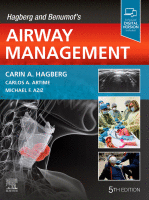Physical Address
304 North Cardinal St.
Dorchester Center, MA 02124

KEY POINTS When faced with a difficult airway (DA), awake intubation is the gold standard for airway management. There are no absolute contraindications to awake intubation other than patient refusal, or a patient who is unable to cooperate (e.g., a…

Key Points Airway management occurs within the broad and complex sociotechnical system of healthcare delivery. Aspects of design, training, and team functioning can be modified to improve safety. Airway management is now a “team sport,” and interventions to improve safety…

Key Points Adherence to the principles of an airway management algorithm and widespread adoption of such a structured plan should result in a reduction of respiratory catastrophes and a decrease in perioperative morbidity and mortality. Airway evaluation should consider any…

“I have no intention of following the algorithm down to a surgical airway … can’t we just do a spinal?” Anonymous Resident Key Points Decision bias can be reduced by considering each aspect of airway management separately. The utility of…

KEY POINTS Poor airway assessment may contribute to poor patient outcomes. An airway history and physical examination should be performed in all patients undergoing airway management. Relevant diagnostic studies should be reviewed. No single test reliably predicts difficult mask ventilation…

Key Points The inability to manage a difficult airway (DA) is responsible for a large proportion of deaths and morbidity directly attributable to anesthesia. While it is important to have common definitions for common problems, the literature continues to report…

Key Points Laryngoscopy can variably induce bradycardia (via the vagal nerve) or hypertension (HTN) and tachycardia (mediated by the cardioaccelerator nerves and sympathetic chain ganglia). The former is most common in infants and children, whereas the latter is typical for…

KEY POINTS The selection of pharmacologic agents should consider the effects on airway patency, airway reflexes, and airway reactivity. Delivery of inhalational drugs should be optimized to prevent inefficient administration, and dedicated devices may be necessary to increase the amount…

Key Points The ventilated gas that participates in gas exchange is referred to as alveolar ventilation (V˙ a ). The volume of gas that is wasted is referred to as dead space (V d ). The aggregate total of dead…

Key Points An important formula that quantifies the relationship of pressure, flow, and resistance in laminar flow systems is given by the Hagen-Poiseuille equation. This law states that the fluid flow rate through a horizontal straight tube of uniform bore…